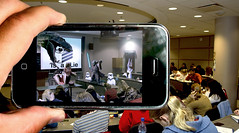
- Image by turkletom via Flickr
In my opinion augmented reality will not become mainstream until 2012, there is time to prepare. However, in the meantime it is important to understand what augmented reality is today, what it could become in the future, and how you could potentially weave it into how you do business today and tomorrow.
After watching this brief (48 second) YouTube video for augmented reality company Tagwhat I decided to reach out and learn more about their business. First, the video:
Tagwhat was founded by Dave Elchoness, Don Cramer, and Angus Shee in the middle of 2009. Angus, Dave, and I chatted (while Don was busy coding), so that I could learn a bit more. In June of 2009 they were building many of the early layers for the Layar browser, including Yelp, Wikipedia, Eat, and Drink, and soon decided to build their own platform. This platform, Tagwhat, launched in May/June of this year.
In many ways Tagwhat is both a business and a research project. They have great technology, sure, but they are working with early adopters to see how people are using it and understand what types of real business problems augmented reality can help solve.
One of their potential early adopters is the State of Colorado. Laura Gray, who works with Film, TV, and Media in the Government of Colorado immediately saw the possibilities for Tagwhat. Some possible ideas for Colorado?
- On-location movie trailers highlighting work that has already been done in the area.
- 3 dimensional landscapes that historic societies could use to highlight the rich history in certain areas.
- Photos put around certain tourist spots to highlight must see areas.
There are, of course, dozens of potential uses for augmented reality, including:
- Training exercises and team building. One company, cannot name it unfortunately, has dropped tags throughout their complex to highlight fun facts and corporate history.
- For RFID and other related tracking uses.
- For local governments looking to post information about costs, revenues, and more, without cluttering our real world views.
- For politicians looking to construct layers showing the value they have added (maybe highlighting school or police force additions) or to spotlight what the opposing candidate is going to eliminate (showing schools cut in half or removed as an example).
While the potential is there, what does Tagwhat provide today?
First off, it’s free to use their web and mobile applications (iPhone and Android devices only). The web application is very easy to use. Create your account and adding augmented reality tags is simple. For example, want to leave a tag in Boston’s Christopher Columbus Park?
 First, find it on your map and then double-click on the location where you want to leave the tag.
First, find it on your map and then double-click on the location where you want to leave the tag.
From here, add a short title, a slightly longer description, upload a photo if desired, and submit it. Bam, your tag is now ready for everyone to check out.
Want to spread the word? Easy, as you add the tag you can tweet it or share it with your Facebook friends.
Want to leave the tag but only for selected people to find? Again, easy to do. Tagwhat supports the basic Following/Follower model you find in Twitter, Foursquare, and other social networking communities. You can add the tag and choose to share it only with a specific person or group of people, which opens the door to some other interesting potential uses for monetizing layers or tags.
One thing that I have already found to be useful is the ability to add web URLs within the tag. For example, I am highlighting featured jobs in the Boston area, as you probably know. This is done in partnership with Chase Technology Consultants so I have added a tag at their building with a link back to our featured jobs. For example, this is what it looks like in the web interface:
 You can see that the link can be clicked upon and the user will be taken to the web page with the full listing of jobs. In the mobile interface it provides the same capability, only with a slightly slicker user interface.
You can see that the link can be clicked upon and the user will be taken to the web page with the full listing of jobs. In the mobile interface it provides the same capability, only with a slightly slicker user interface.
It gets better, though, in the fact that other users can interact with your tag, leaving comments for example. An entire thread of social conversation can be related to the tags throughout the augmented social universe, adding a dynamic level to whatever you leave in place.
The potential is unlimited, as I have noted several times. Businesses of all sizes, government entities, politicians, and others have an entire range of possibilities from the simple act of adding tags to working with developers to create entire new layers, essentially new realities. What comes next is only limited by our imaginations.
John
Originally posted on Government in Action.




If you’re interested in augmented reality, here are two ridiculously awesome sites: http://www.thefwa.com/ and http://www.fborn.com/. You should also link up with Ivan Djordjevic @ivandj who has actually done augmented reality. He’s a genius…
Caveat – I used to work with Ivan so I’m a little biased, but still, uber smart guy…he’s in DC…